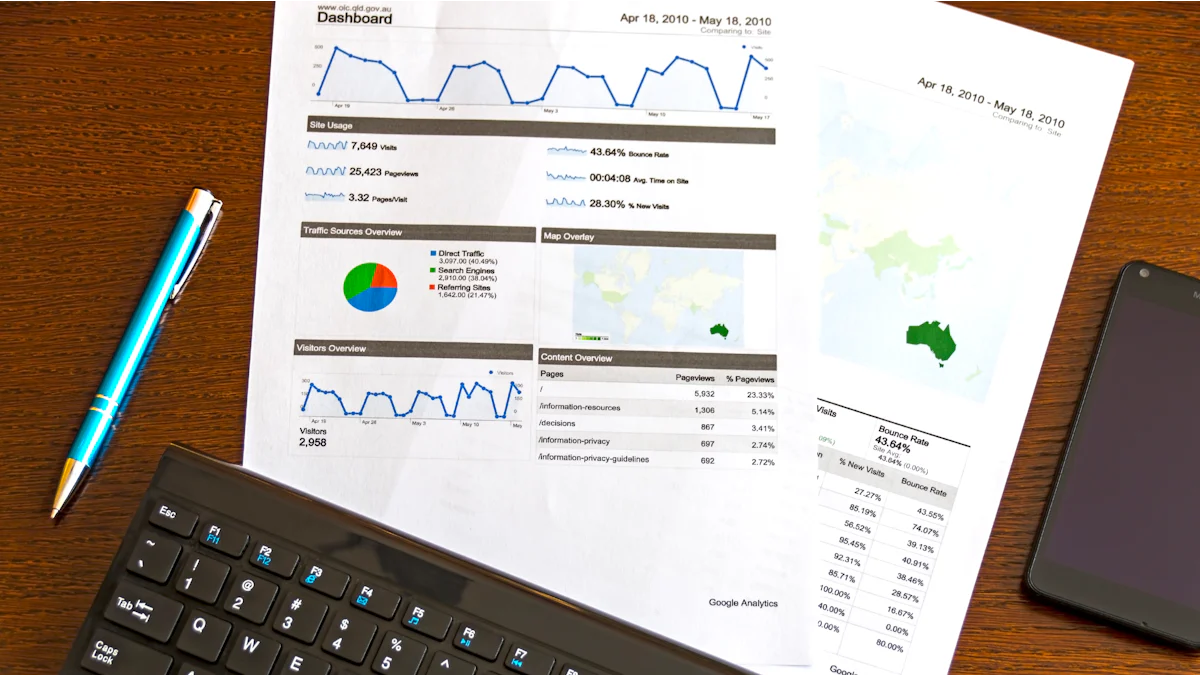


An Executive Dashboard serves as a vital tool for business leaders. It provides a visual representation of key performance indicators (KPIs) essential for strategic decision-making. Executives rely on these dashboards to access real-time data, enabling them to make informed choices swiftly. Data visualization plays a crucial role in this process, offering clarity and insight into complex datasets. By presenting information graphically, executive dashboards enhance understanding and facilitate quick analysis, ultimately driving business success.
Understanding the Executive Dashboard
Definition and Purpose of an Executive Dashboard
What is an Executive Dashboard?
An Executive Dashboard serves as a centralized interface that displays key performance indicators (KPIs) and critical data points. It aggregates information from various departments, presenting it in a cohesive and easily digestible format. This tool allows executives to monitor their organization's performance at a glance, providing a comprehensive overview of business operations. By leveraging visual widgets, executive dashboards transform complex datasets into intuitive and actionable insights.
Purpose in Business Context
In a business context, the Executive Dashboard plays a pivotal role in strategic decision-making. It empowers leaders to make agile, data-driven decisions that enhance productivity, drive revenue growth, and mitigate risks. By consolidating data from multiple sources, the dashboard offers a holistic view of the organization, enabling executives to identify trends, predict outcomes, and manage team goals effectively. The real-time nature of these dashboards ensures that decisions are based on the most current and relevant information available.
Key Components of an Executive Dashboard
Data Sources
Executive Dashboards draw data from a myriad of sources, including internal databases, external APIs, and cloud-based platforms. This integration allows for a seamless flow of information, ensuring that the dashboard reflects the latest data. The ability to aggregate data from diverse sources into a single platform is crucial for providing a comprehensive view of the organization's performance.
Metrics and KPIs
The selection of appropriate KPIs is essential, as they guide decision-making and strategic planning.
Visualization Tools
Visualization tools are integral to the effectiveness of an Executive Dashboard. They transform raw data into graphical representations, such as charts, graphs, and tables. These visualizations facilitate quick comprehension and analysis, allowing executives to identify patterns and anomalies with ease. Customization options enable the tailoring of dashboards to meet specific executive needs, enhancing their utility and relevance.
Features of an Effective Executive Dashboard

User-Friendly Interface of an Executive Dashboard
Intuitive Design
An effective Executive Dashboard prioritizes intuitive design. Executives need to access information quickly without navigating complex interfaces. A well-designed dashboard uses clear layouts and logical organization. This approach ensures that users can find critical data effortlessly. By employing visual widgets and straightforward navigation, dashboards enhance user experience and efficiency.
Customization Options
Customization options are vital for tailoring the Executive Dashboard to specific needs. Different executives may require distinct data views. Customizable dashboards allow users to select relevant metrics and KPIs. This flexibility ensures that the dashboard aligns with individual business goals and preferences. By offering personalization, dashboards become more relevant and valuable to each user.
Real-Time Data Access
Importance of Timeliness
Real-time data access is crucial for effective decision-making. Executives rely on the most current information to guide strategies and actions. An Executive Dashboard provides up-to-date insights, enabling leaders to respond swiftly to changes. Timeliness enhances the ability to predict trends and manage risks, ultimately driving better business outcomes.
Integration with Data Systems
Integration with various data systems ensures that the Executive Dashboard reflects comprehensive and accurate information. By connecting to internal databases, external APIs, and cloud platforms, dashboards consolidate data seamlessly. This integration supports a unified view of the organization's performance, allowing executives to make informed decisions based on a complete picture.
Benefits of Using a Executive Dashboard
Enhanced Decision-Making
Data-Driven Insights
An Executive Dashboard empowers leaders with data-driven insights. By consolidating information from various sources, it provides a clear picture of organizational performance. Executives can identify trends, assess risks, and uncover opportunities. This tool removes guesswork, enabling informed decisions that align with strategic goals.
Quick Access to Critical Information
Executives need quick access to critical information. An Executive Dashboard delivers this by presenting key metrics and KPIs in an easily digestible format. Leaders can swiftly evaluate business health and make timely adjustments. This efficiency enhances the ability to respond to market changes and optimize strategies.
Improved Efficiency
Streamlined Reporting
An Executive Dashboard streamlines reporting processes. It automates data collection and visualization, reducing manual effort. Executives receive comprehensive reports without delays, allowing them to focus on analysis rather than data gathering. This streamlined approach improves productivity and decision-making speed.
Time-Saving Features
Time-saving features are integral to an Executive Dashboard. By providing real-time updates and customizable views, it minimizes the time spent searching for information. Executives can tailor dashboards to their specific needs, ensuring relevant data is always at their fingertips. This efficiency supports better resource allocation and strategic planning.
Practical Examples of a Executive Dashboard

Executive Dashboards have become indispensable tools across various industries. They provide tailored insights that cater to specific sector needs, enhancing decision-making and operational efficiency.
Industry-Specific Dashboards
Finance
In the finance industry, Executive Dashboards play a crucial role in monitoring financial health and performance. They offer real-time access to critical metrics such as revenue, expenses, and profit margins. Financial executives rely on these dashboards to track market trends, assess risk, and ensure regulatory compliance. By visualizing complex financial data, dashboards enable quick analysis and strategic planning. This capability supports informed decisions that drive profitability and growth.
Healthcare
Healthcare organizations utilize Executive Dashboards to improve patient care and operational efficiency. These dashboards consolidate data from various departments, including patient records, staffing, and inventory management. Healthcare executives can monitor key performance indicators like patient wait times, treatment outcomes, and resource utilization. By providing a comprehensive view of hospital operations, dashboards facilitate better resource allocation and enhance patient satisfaction. They also support compliance with healthcare regulations by ensuring data accuracy and accessibility.
Lessons Learned
From these case studies, several lessons emerge. First, successful Executive Dashboard implementations require a clear understanding of user needs and business goals. Customization options should align with these requirements to maximize dashboard utility. Second, integration with existing data systems is essential for providing accurate and comprehensive insights. Finally, ongoing training and support ensure user adoption and effective utilization of the dashboard's features.
Best Practices for Designing a Executive Dashboard
Focus on User Needs
Understanding Executive Requirements
Designing an Executive Dashboard begins with understanding the specific needs of executives. They require quick access to critical data that aligns with their strategic goals. By identifying these requirements, designers can tailor dashboards to provide relevant insights. This approach ensures that the dashboard serves as a valuable tool for decision-making.
Aligning with Business Goals
Aligning the Executive Dashboard with business goals enhances its effectiveness. Designers should select KPIs that reflect the company's performance across various metrics, such as financial and operational aspects. This alignment ensures that the dashboard supports strategic objectives and provides a comprehensive view of the organization's health.
Prioritize Clarity and Simplicity
Avoiding Information Overload
Clarity is crucial in an Executive Dashboard. Overloading users with excessive information can hinder decision-making. Designers should focus on presenting only the most relevant data. By prioritizing clarity, dashboards transform complex data into actionable insights, empowering executives to make informed decisions swiftly.
Clear Visual Hierarchy
A clear visual hierarchy helps users navigate the Executive Dashboard efficiently. Proper placement of charts and metrics allows executives to find information quickly. Visually organized dashboards enhance user experience by making data easily accessible. This organization supports seamless interaction and engagement with the dashboard.
Challenges and Solutions of a Executive Dashboard
Common Challenges
Data Quality Issues
Data quality issues often pose significant challenges for executive dashboards. Inaccurate or outdated data can lead to misguided decisions. Organizations may struggle with inconsistent data sources, leading to discrepancies in reporting. Ensuring data integrity becomes crucial for maintaining the reliability of the dashboard.
User Adoption
User adoption is another common hurdle. Executives may resist new technology due to unfamiliarity or perceived complexity. A lack of engagement can result in underutilization of the dashboard's capabilities. Encouraging user adoption requires addressing user concerns and demonstrating the dashboard's value.
Solutions and Strategies
Ensuring Data Accuracy
To ensure data accuracy, organizations must implement robust data management practices. Regular audits and validation processes help maintain data integrity. Integrating automated data collection reduces human error. By prioritizing data quality, businesses can enhance the credibility of their dashboards.
Training and Support
Providing comprehensive training and support fosters user adoption. Tailored training sessions can address specific user needs and preferences. Ongoing support ensures that executives feel confident using the dashboard. By offering resources and assistance, organizations can maximize the dashboard's impact and utility.
Guidance on Implementation of a Executive Dashboard
Steps to Implement an Executive Dashboard
Planning and Strategy
Implementing an executive dashboard begins with meticulous planning and strategy. Organizations must first identify the specific goals they aim to achieve with the dashboard. This involves understanding the key performance indicators (KPIs) that align with business objectives. By prioritizing these metrics, companies can ensure that the dashboard provides relevant insights. Additionally, engaging stakeholders in the planning phase fosters a shared vision and sets clear expectations.
Execution and Monitoring
Execution involves the technical setup and integration of data sources. Teams should focus on ensuring seamless data flow from various systems into the dashboard. This step requires collaboration between IT professionals and business analysts to maintain data accuracy and consistency. Once the dashboard is operational, continuous monitoring becomes essential. Regular reviews help identify areas for improvement and ensure the dashboard remains aligned with evolving business needs.
Selecting the Right Tools
Evaluation Criteria
Choosing the right tools for an executive dashboard requires careful evaluation. Organizations should consider factors such as ease of use, scalability, and integration capabilities. Tools that offer intuitive interfaces and customization options enhance user experience. According to the Aberdeen Group Study on Visualized Analytics, managers using visualized analytics are almost 30% more likely to find information to support their decisions on time. Therefore, selecting tools with robust visualization features is crucial.
Vendor Comparison
Comparing vendors involves assessing their offerings against the organization's requirements. Companies should evaluate the vendor's track record, customer support, and pricing models. Engaging in product demonstrations and seeking feedback from existing users can provide valuable insights. By conducting thorough vendor comparisons, organizations can select a solution that best fits their needs and budget. This strategic approach ensures that the chosen dashboard tool delivers maximum value and supports long-term business success.
Executive dashboards play a crucial role in enhancing business performance. They provide leaders with a clear view of key metrics and trends, enabling informed decision-making. By adopting these tools, organizations can improve teamwork and focus on strategic goals. For those interested in leveraging executive dashboards, consider evaluating your current data needs and exploring available dashboard solutions. This proactive approach will ensure that your organization remains competitive and efficient in today's data-driven landscape.
FAQ
An Executive Dashboard is a tool that provides a unified view of critical data. It helps executives monitor business performance at a glance. By displaying key performance indicators (KPIs) in one location, it enables agile, data-driven decisions. This tool is essential for leaders who need to focus on significant business aspects.
Executive Dashboards are crucial because they offer real-time insights into business operations. They allow leaders to identify trends, uncover opportunities, and make strategic adjustments. By providing a holistic view of business activities, dashboards help improve productivity, enhance revenue growth, and mitigate risks.
These dashboards enhance decision-making by presenting the most current and relevant information. They consolidate data from various sources, making it easier for executives to analyze and interpret. This capability empowers leaders to make informed decisions swiftly, which is vital in today's fast-paced business environment.
An effective Executive Dashboard should have a user-friendly interface, real-time data access, and customization options. It should integrate seamlessly with existing data systems and provide clear visualizations. These features ensure that the dashboard meets the specific needs of executives and supports their strategic goals.
Yes, Executive Dashboards can be customized to meet the unique needs of different executives. Customization options allow users to select relevant metrics and KPIs. This flexibility ensures that the dashboard aligns with individual business objectives and preferences, making it a valuable tool for decision-making.
Organizations may face challenges such as data quality issues and user adoption. Inaccurate data can lead to misguided decisions, while resistance to new technology can hinder dashboard utilization. Addressing these challenges requires robust data management practices and comprehensive training and support for users.
To ensure success, organizations should focus on understanding executive requirements and aligning the dashboard with business goals. They should prioritize data accuracy and provide ongoing training and support. By engaging stakeholders and selecting the right tools, companies can maximize the dashboard's impact and utility.
Continue Reading About Executive Dashboard
Covers Dashboard: Find Your Perfect Match
Choose the perfect covers dashboard to protect and style your car, enhancing its interior and resale value with the right material and fit.
Lewis
Nov 05, 2024
Dashboard Cover Choices: Materials and Colors Explained
Discover the best dashboard cover materials and colors to protect and enhance your vehicle's interior with style and functionality.
Lewis
Nov 05, 2024
Draft Dashboard Review - Is It the Ultimate DFS Tool?
Review the Draft Dashboard, a top DFS tool with real-time data, predictive analytics, and lineup optimization. Compare features and pricing with competitors.
Lewis
Oct 21, 2024
Dynamic Dashboard: A Game Changer for Data Analysis
Dynamic dashboard revolutionize data analysis with real-time insights, customization, and improved decision-making. Explore their impact and future trends.
Lewis
Oct 11, 2024
How Dashboard Blooket Transforms Student Engagement in the Classroom
Discover how Dashboard Blooket boosts student engagement with interactive games, and personalized learning content. Transform your classroom!
Lewis
Oct 26, 2024
How to Access the Clover Dashboard Easily
Access the Clover Dashboard easily with our guide. Learn login methods, device compatibility, and security tips for seamless business operations.
Lewis
Oct 30, 2024


